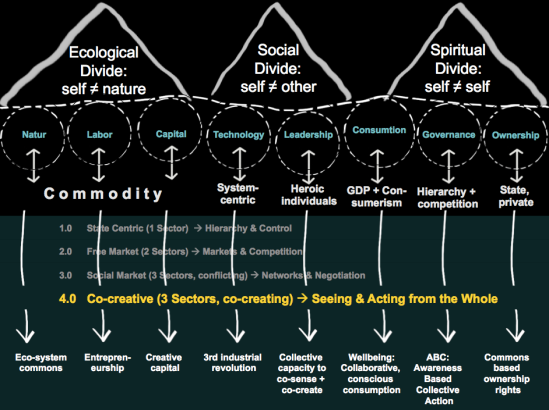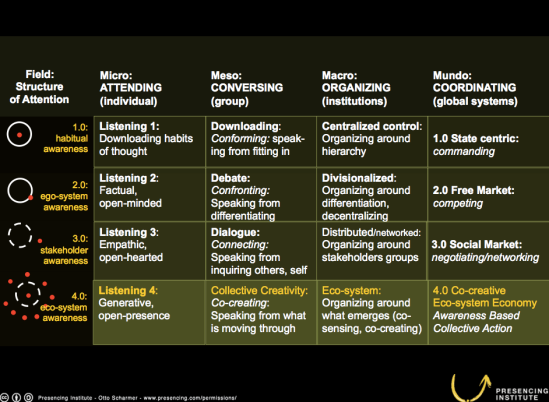The problem with capitalism originates between our ears!
– by Otto Scharmer of Theory-U and Presencing Institute brings the best-ever overview of requirements of the Transition Narrative (ecoNVERGE / @ Econologics) for humanity to evolve to a new Paradigm Shift.
Profound personal, societal and global renewal is not only possible; it is crucial for our planetary future. What is needed are change makers willing to lead from the emerging future; leaders who are willing to learn about and practice the journey from ego-system to eco-system economies. We have the places, living examples, frameworks and tools in hand. Now what we need is the co-creative vision and the common will to bringing it into reality.
10 insights from our new book Leading From the Emerging Future: From Ego-system to Eco-system Economies
We live in an age of profound disruption. Global crises, such as finance, food, fuel, water, resource scarcity and poverty challenge just about every aspect of society. Yet, this disruption also brings the possibility of profound personal, societal and global renewal. We need to stop and ask: Why do we collectively create results nobody wants? What keeps us locked into the old ways of operating? And what can we do to transform these root issues that keep us trapped in the patterns of the past?
1) The root cause of today’s global crises originates between our ears — in our outdated paradigms of economic thought
A structural disconnect between:
- the infinite growth imperative and the finite resources of planet earth;
- between the Haves and the Have Nots;
- between the financial and the real economy;
- between technology and real societal needs;
- between institutional leadership and people;
- between gross domestic product (GDP) and actual well-being;
- between governance mechanisms and the voiceless in our systems; and
- between actual ownership forms and best societal use of property.
2) The blind spot of modern economic thought can be summarized with a single word: consciousness
3) The evolution of the economy and of modern economic thought mirrors the footprints of an evolving human consciousness
The stages of economic development that come with them:
- 1.0 Organizing around centralized coordination
- 2.0 Organizing around decentralized coordination
- 3.0 Organizing around special interest group driven coordination
- 4.0 Organizing around commons
4) To paraphrase Einstein, the problem with today’s capitalism is that we are trying “to solve problems with the same consciousness that created them”
5) Helping stakeholder systems shift their way of operating from ego-system to eco-system awareness is the central leadership challenge of our time
6) The shift from ego-system to eco-system awareness requires a journey that involves walking in the shoes of other stakeholders and attending to the three instruments of inner knowing: open mind, open heart, and open will
The effectiveness of accessing these three instruments depends on the ability to deal with the sources of resistance (“three enemies”):
- VoJ (Voice of Judgment): The VoJ shuts down the Open Mind by habitually judging self and others. All creativity techniques start with somehow suspending the VoJ.
- VoC (Voice of Cynicism): The VoC shuts down the Open Heart by offering an easy alternative to making oneself vulnerable. The problem with that easy exit is that it does the same thing as the VoJ: it blocks one’s opening process for accessing the deeper sources of creativity.
- VoF (Voice of Fear): The VoF tends to shut down the Open Will by not letting go but holding on to old identities, ideologies, and Us vs. Them belief structures.
7) Addressing the current global crisis at its root calls for a 4.0 update of the economic operating system through reframing eight “acupuncture points” of the global economic system
They are:
- Nature: Close the feedback loop of production, consumption, reuse, and recycling through “earth-to-earth” or closed-loop design.
- Labor: Close the feedback loop from work (jobs) to Work (passion) by building infrastructures that foster and ignite inspired entrepreneurship.
- Capital: Close the feedback loop of capital by redirecting speculative investment into ecological, social, and cultural-creative renewal.
- Technology: Close the feedback loop from technology creation to societal needs in underserved communities through needs assessment and participatory planning.
- Leadership: Close the feedback loop from leadership to the emerging future of the whole through practices of co-sensing, co-inspiring, and co-creating.
- Consumption: Close the feedback loop from economic output to the well-being of all through conscious, collaborative consuming and through new well-being indicators such as GNH (Gross National Happiness).
- Coordination: Close the feedback loop in the economy from the parts to the whole through ABC (awareness-based collective action).
- Ownership: Close the feedback loop from ownership rights to the best societal use of assets through shared ownership and commons-based property rights that safeguard the interests of future generations.
8) Shifting the system to 4.0 requires a threefold revolution
Inversion means turning inside-out and outside-in:
- Individual inversion means to open up thinking (open mind), feeling (open heart), and will (open will) in order to learn to act as an instrument for the future that is wanting to emerge.
- Relational inversion means to open up communicative relationships from downloading (conforming) and debate (defending) to dialogue (reflective inquiry) and collective creativity (flow) in order to tune as groups into the field of the future.
- Institutional inversion means to open traditional institutional geometries of power from 1.0 and 2.0 forms of coordinating and organizing — centralized hierarchy and decentralized competition — to 3.0 and 4.0 forms of coordinating around co-creative stakeholder relationships in eco-systems that generate well-being for all.
the three transformations for the individual (column 1), the relational (column 2) and the institutional inversion (column 3 and 4) in the form of a Matrix of Social Evolution that integrates all system levels (micro-meso-maco-mundo) and all structures of awareness (1.0 to 4.0).
9) We need new types of innovation infrastructures in order to build collective leadership capacities on a massive scale
These infrastructures will include:
- Co-initiating: Creating spaces for convening stakeholders around a shared eco-system
- Co-sensing: Going to the places of most potential and observing with one’s mind and heart wide open
- Co-inspiring: Creating spaces for connecting to the sources of creativity and self
- Co-creating: Creating spaces for exploring the future by doing (prototyping)
- Co-shaping: Creating spaces for embodying and scaling the new through practices
10) The shift from an ego-system to an eco-system economy requires a global movement that needs to be supported by a new leadership school. That school should create collaborative platforms across sectors, systems, and generations and work through integrating science, art, and the practice of profound, awareness-based change
Such a new leadership school would be a home base for the emerging global movement of 4.0-related transformation journeys. At the same time, it would prototype a 21st century action university that integrates three forms of knowledge:
- technical knowledge (know-what),
- practical knowledge (know-how) and
- transformation knowledge (know-who: self knowledge).
Set of principles that are essential for this type of school and which are designed for global-local replication:
- Engage systems at all levels and states: Engage systems by using the entire Matrix of Social Evolution.
- Engage all levels of intelligence: Integrate open mind (IQ: intellectual knowledge), open heart (EQ: emotional and relational knowledge), and open will (SQ: self knowledge).
- Systems Thinking: Integrate methods and tools derived from 30 years of organizational learning research and practice.
- MOOCs: Use massive open online courses that combine course delivery with interactive personal, small-group dialogue and the presence of a global community of change makers that effects transformative change.
- Deep immersion: Use deep dive learning journeys and generative listening practices in order to connect communities and places of most potential.
- Science 2.0: Use scientific methods that let the “data talk to you.” The challenges of this century involve extending the concept of science beyond looking exclusively at exterior data (third-person view). We need to bend the beam of scientific observation back upon the observer in order to investigate the more subtle levels of experience of the second- and first-person view.
- Presencing: Use practices that allow leaders to sense and actualize the emerging future and to clarify the two root questions of creativity: Who is my Self? What is my Work?
- Power of Intention: Focus on the capacity to connect with the deeper intention of one’s journey, connecting us more deeply with one another, the world and ourselves.
- Prototyping: Link head, heart, and hand in order to create living examples and prototypes that allow us to explore the future by doing.
- Power of Place: Complement the massive expansion of online learning with an equally massive global network of vibrant entrepreneurial hubs that focus on activating co-sensing and co-creating as a gateway for unleashing entrepreneurial potential. Great innovations happen in places. Learning how to design and hold spaces for reflection, generative conversation, and system-wide transformation is a mission critical capacity today.














You must be logged in to post a comment.